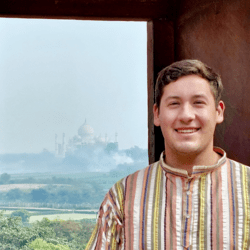Vol. 1: Letters to The World From a Thai Classroom - Thailand Through Thai Eyes: Our Culture & Our Pride
What do you want the world to know about Thailand?
That’s the question I asked my Thai high school students, and these are their honest, heartfelt and powerful answers.
I reminded my students that, sadly, much of the Western world — places like the U.S.A., Canada, Western Europe, Australia, and New Zealand — often sees only a narrow, sometimes distorted image of Thailand. Misinformation, outdated portrayals, and negative stereotypes have too often defined the narrative of what Thailand represents.
As someone fortunate enough to live here, I’ve come to see a different Thailand — one that deserves to be known for its people, values, and spirit. But instead of speaking for Thai people, I asked my students to speak for themselves.
In this first volume, what follows are their words, unfiltered, sincere, and filled with love for their country. This is how they want Thailand to be remembered…
“One part of Thai culture and history I’m proud about is our open-mindedness. Thai people always help each other and that makes them trust each other too. Many foreigners compliment Thai people because they respect everyone. We respect every gender equality in our society. We are very open-minded and have a good perspective on LGBTQ+ people. That’s why all are welcome to travel here free of judgement and inequality. They can feel truly free.”
— Panyawee R.
“One Thai value that has helped guide me in life is the belief in karma and making merit. This belief teaches that all of our actions – good or bad – will lead to consequences, not only in this life but also in the next. It encourages me to be kind, respectful and generous to others. Whether it’s helping someone in need or simply being polite, I believe these good deeds will return to me in a positive way. This value has kept me grounded and reminded me to be a better person, even during difficult times. If everything you do today will shape your tomorrow, what kind of future are you creating with your actions right now?”
— Nattakorn Auykhiphan
“I am proud of many aspects of Thai culture, history and daily life.
1. The beautiful and gentile Thai culture, such as Thai mannerisms of showing respect and humility.
2. The strong and enduring Thai history as Thailand is one of the few countries in Asia to ever be a colony of a western nation.
3. Diversity and uniqueness of Thai food. Each region has its own menu that reflects its local identity, such as Khao Soi from the north and Som Tam from the Northeast.
4. Thai handicrafts and art. Thai art, such as murals, Thai dance and Thai music have its own unique identity.”
— Noey
“Thailand is unique because it blends culture and tradition with everyday life. People greet each other with a “wai”, a gesture showing humility and kindness by placing your hands together and bowing slightly into your hands. In Thailand kindness is seen daily in helping lost tourists, sharing food, or assisting neighbors without expecting anything in return. Finding joy and sharing kindness is central to Thai life.”
— Benyapa Polyiam
“One thing I wish the world knew about Thailand is “khwan”. This is a ritual aimed at revitalizing and strengthening Khwan, which can be loosely translated as the life force or spirit. A person’s Khwan can be scattered or weakened by shock, fear or a significant life change. The ceremony is performed to call the “Khwan” back to the person’s body restoring their confidence, mental strength and sense of peace. Thai beliefs are rooted in many parts whether it is Buddhism, or tradition. There is the belief in demons and supernatural things that have been inherited since ancient times. These beliefs are not just about rituals but also infiltrate the daily life of Thai people so much that it has become a part of the culture.”
— Chalisa Rodto
“One beautiful Thai tradition I wish more people knew about is Loy Krathong. It’s a festival that happens in November. On this day, people make small baskets called “Krathongs” using banana tree stems, leaves, flowers and candles. At night, we float them onto the river or in lakes. We do this to say thank you to the water and to ask for forgiveness for using and polluting it. The lights on the water look very beautiful, and many people make wishes for good luck. It’s a peaceful and magical night. But Loy Krathong isn’t just about beauty but also shows our love and respect for nature. Families and friends come together, and share this happy time. In some places there are fireworks, shows, and music. I think Loy Krathong is a very special tradition that shows the heart of Thais. I hope more people around the world learn about this tradition and maybe visit Thailand to see it for themselves.”
— Doungkamon Chimtabtim
“Thailand has traditions for each province or region. One beautiful tradition not a lot of foreigners know about is the candle processions in the Ubon Ratchathani Province. Here small candles are all melted to make a large candle. That candle is then carved into beautiful shapes. Each district competes with each other to make the most beautiful candle carving and then they are paraded around the city with Thai dance performances. It is a fun and beautiful tradition.”
— Chanidapa Charoen
“A tradition I am proud of in our many Thai traditions is Songkran. It’s not just a water fight — it’s a time to pay respect to elders and start a new year with joy and blessings. If tourists understood the real meaning of this tradition, they would appreciate Thai culture even more.”
— Napapron Auttapan
Closing Thoughts:
These quotes speak not just of culture, but of connection. In a world rushing for profit and aggressive ambition, Thailand’s traditions remind us to pause, reflect, and treat one another with kindness and grace. If we want to truly understand a place, we must listen to its people and understand their culture through a non-Western lens.
Related Posts

Teaching in Thailand: Expecting the Unexpected and Redefining Productivity
One of the most magical (and, at times, frustrating) things about being an English teacher in Thailand is how chaotic and spontaneous everything is. Before I arrived, I had so... keep reading
Unexpected Things I Wish I Knew Before Moving to Thailand: The Ultimate Guide to Living in Thailand
I'm sure you've read enough big-picture descriptions of daily life as an American expat living in Thailand. Now, indulge in some of the quirks and seemingly small idiosyncrasies that define daily life here, based on my personal experience living right outside of Bangkok.

A Day in My Life Teaching Kindergarten
Before moving overseas, one question that constantly circled my mind was: What will my everyday life look like? I had lots of ideas, but I quickly realized it's impossible to... keep reading

